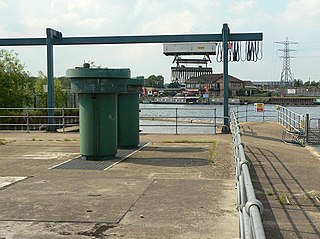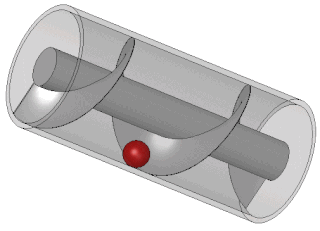
Small hydro is the development of hydroelectric power on a scale suitable for local community and industry, or to contribute to distributed generation in a regional electricity grid. Exact definitions vary, but a "small hydro" project is less than 50 megawatts (MW), and can be further subdivide by scale into "mini" (<1MW), "micro" (<100 kW), "pico" (<10 kW). In contrast many hydroelectric projects are of enormous size, such as the generating plant at the Three Gorges Dam at 22,500 megawatts or the vast multiple projects of the Tennessee Valley Authority.

Pumped-storage hydroelectricity (PSH), or pumped hydroelectric energy storage (PHES), is a type of hydroelectric energy storage used by electric power systems for load balancing. The method stores energy in the form of gravitational potential energy of water, pumped from a lower elevation reservoir to a higher elevation. Low-cost surplus off-peak electric power is typically used to run the pumps. During periods of high electrical demand, the stored water is released through turbines to produce electric power. Although the losses of the pumping process make the plant a net consumer of energy overall, the system increases revenue by selling more electricity during periods of peak demand, when electricity prices are highest. If the upper lake collects significant rainfall or is fed by a river then the plant may be a net energy producer in the manner of a traditional hydroelectric plant.

Radyr is an outer suburb of Cardiff, about 4 miles (6.4 km) northwest of Cardiff city centre. Radyr is part of Radyr and Morganstown Community, for which the 2011 Census recorded a population of 6,417.

The Rubicon Hydroelectric Scheme is a small run-of-the-river hydroelectric scheme located on the Rubicon and Royston Rivers, north east of Melbourne, 40 km (25 mi) south-west of Alexandra, Victoria, Australia. The scheme commenced in 1922, and was the first state-owned hydroelectric scheme to generate electricity in mainland Australia, and among the first in the world to be remotely controlled. For the first ten years of its operation it supplied on average 16.9% of electricity generated by the State Electricity Commission of Victoria. It is now owned and operated by AGL Energy and contributes approximately 0.02% of Victoria's energy supply.

Pico hydro is a term used for hydroelectric power generation of under 5 kW. These generators have proven to be useful in small, remote communities that require only a small amount of electricity – for example, to power one or two fluorescent light bulbs and a TV or radio in 50 or so homes. Even smaller turbines of 200–300 W may power a single home with a drop of only 1 metre (3.3 ft). Pico-hydro setups typically are run-of-stream, meaning that a reservoir of water is not created, only a small weir is common, pipes divert some of the flow, drop this down a gradient, and through the turbine before being exhausted back to the stream.
Low-head hydropower refers to the development of hydroelectric power where the head is typically less than 20 metres, although precise definitions vary. Head is the vertical height measured between the hydro intake water level and the water level at the point of discharge. Using only a low head drop in a river or tidal flows to create electricity may provide a renewable energy source that will have a minimal impact on the environment. Since the generated power is a function of the head these systems are typically classed as small-scale hydropower, which have an installed capacity of less than 5MW.

Torrs Hydro is a micro hydroelectric scheme, owned by the community, in New Mills, Derbyshire. It is located on the River Goyt, immediately after its confluence with the River Sett at the Torr weir. A 2.4-metre diameter steel trough screw turbine generates up to 63 kW of electricity.

Settle Hydro is a micro hydroelectric scheme, owned by the community, in Settle, North Yorkshire, England. It is located on the River Ribble, at Settle Weir near Bridge End Mill. It generates 50 kW of electricity using a screw turbine in part of the former mill race.

The Cruachan Power Station is a pumped-storage hydroelectric power station in Argyll and Bute, Scotland. The scheme can provide 440 MW of power and produced 705 GWh in 2009.

The Monmouth New Hydro Scheme, which incorporates the Osbaston fish pass, is a hydroelectric scheme in Osbaston, near Monmouth, in South-East Wales.

Beeston Hydro is a small hydroelectric scheme, in Beeston, Nottinghamshire. It is located on the River Trent, and generates up to 1.66 MW of electricity.
The Nadarivatu Dam, also known as the Korolevu Dam, is a concrete gravity dam on the upper reaches of the Sigatoka River in Nadarivatu District of Nadroga-Navosa Province, Fiji. The primary purpose of the dam is to generate hydroelectric power in a 41.7 megawatts (55,900 hp) run-of-the-river scheme. The Nadarivatu Hydropower Scheme was first identified in 1977 during a hydropower study. Detailed plans for the project were developed in 2002 and major construction began in 2009. The power station was commissioned on 7 September 2012 but an inauguration ceremony led by Prime Minister Frank Bainimarama was held a week later on 14 September. Funding and loans for the project was provided by several organizations to include the China Development Bank, Fiji Electricity Authority bonds, ADZ Bank. The 40 m (130 ft) tall dam diverts water from the Sigatoka River through a 3,225 metres (10,581 ft) long headrace/penstock tunnel to a power station along the Ba River to the southwest. The power station contains two 20.85 megawatts (27,960 hp) Pelton turbine-generators. The drop in elevation between the reservoir and the power station affords a gross hydraulic head of 335.7 metres (1,101 ft).

A screw turbine is water turbine that converts the potential energy of water on an upstream level into work. This hydropower converter is driven by the weight of water, similar to water wheels, and can be considered as a quasi-static pressure machine. Archimedes screw generators operate in a wide range of flows and heads, including low heads and moderate flow rates that are not ideal for traditional turbines and not occupied by high performance technologies.

The Snoqualmie Falls Hydroelectric Plant is located just north of Snoqualmie in King County, Washington state, US. It is situated about 22 mi (35 km) east of Seattle. Located just below the Snoqualmie Falls, the power plant consists of two power houses, Plant 1 and Plant 2. Plant 1 was completed in 1899 and is located underground. It is the first completely underground hydroelectric power plant ever built in the world. Plant 2 was built in 1910 and is located along the right bank of the Snoqualmie River. Both plants receive water from a small reservoir created by a weir atop the falls. Plant 1 has an installed capacity of 13.7 MW and Plant 2 a capacity of 40.2 MW for a total installed capacity of 53.9 MW, enough to power 40,000 homes.

The Pupu Hydro Power Scheme is a small hydroelectric power station near Tākaka in the Golden Bay region of the South Island of New Zealand. It opened in 1929 as the first power station in the region and was the first public electricity supply in Golden Bay. After closing in 1980 following damage to the generator, the power scheme was fully restored by the local Pupu Hydro Society and many volunteer groups over the course of seven years and re-opened in 1988, again supplying electricity to the national grid.

Carrigadrohid hydroelectric power station is a hydroelectric plant located on the River Lee in County Cork, Ireland. It is owned and operated by the ESB Group. The dam is 130 m (427 ft) long and has a single 8 MW (11,000 hp) Kaplan turbine which produces an average of 22 GWh (79 TJ) each year. Built between 1952 and 1957. the construction of Carrigadrohid required the destruction of over half of the Gearagh, an ancient alluvial forest, and initially harmed local wildlife. However, subsequently the area has seen the growth of an ecosystem with kingfishers, otters, salmon and swans, which has been designated European Union Special Area of Conservation.

Cathaleen's Fall hydroelectric power station is a hydroelectric plant located on the River Erne at Ballyshannon in County Donegal, Ireland. Also known as Ballyshannon, it is owned and operated by the ESB Group. The plant consists of two Kaplan turbines providing a combined capacity of 45 MW (60,000 hp) within a concrete gravity dam 257 m (843 ft) long. Constructed between 1946 and 1955, it is the larger of two hydroelectric plants built between Belleek and Ballyshannon at the same time. Despite construction of the dam meaning the destruction of Assaroe Falls, a local beauty spot, Camlin Castle and many other dwellings, there was no local or national resistance to the project. It was the Ireland's first act of major co-operation with Northern Ireland since independence. The site appears in Conor McPherson's The Weir, to represent the fictional location in the play.

Reading Hydro is a micro hydroelectric scheme in Reading, England. It is located on the River Thames, at the upstream end of View Island and using the head of water provided by the weir at Caversham Lock. With a drop of about 1.4 metres and an average water flow of 37 cubic metres (1,300 cu ft) per second, it can generate 46 kilowatts (62 hp) of electricity with its twin archimedes screw turbines.

Sandford Hydro is a small hydroelectric scheme located on the River Thames in Oxfordshire, England. It uses the head of water provided by the weir at Sandford Lock in Sandford-on-Thames, but is actually situated on the opposite bank of the river in Kennington. It can generate 450 kilowatts (600 hp) of electricity with its three archimedes screw turbines. Construction began in 2011, and the plant became operational in 2018.
















